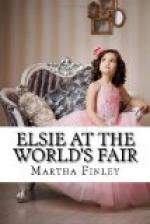They passed in and found a good many sights which interested them—banners and lanterns, and bronze table and dinner set for one person, a cupboard with dishes, a fire pot and tools, boots and shoes of leather, wood, and straw; a kite and reel, a board on which is played a game resembling chess, white and blue vases, and a very old brass cannon used in the American attack on Korean forts in the seventies. Also there were banners hanging on the walls of the booth, and here and there stood screens, one of which was hand-embroidered by the ladies of the palace.
On dummies in the centre of the room were shown ancient warriors’ costumes, the court dress of both a military and a civil official, and a lady’s dress for the dance. And in an upright glass case were shown an embroidered silk cushion, various dress fabrics, a lady’s dress and a lady’s court dress and various articles of footgear.
There was a map showing Korea and adjacent countries, and attached to it was a paper headed, “Questions Answered.”
Mr. Dinsmore stood before it and read of them aloud:
“Korea and Corea are both correct, but the former is preferred.
“Korea is not a part of China, but is independent.
“The Koreans do not speak the Chinese language, and their language resembles neither the Chinese nor the Japanese.
“Korea made treaties in 1882.
“All the articles are owned by the government.
“Korea has electric lights, steamships, telegraph, but no railroads.
“Koreans live in comfortable houses, heated by flues under the floor.
“Korean civilization is ancient and high; area one hundred thousand square miles; population sixteen million; climate like that of Chicago, country mountainous, mineral wealth undeveloped, agricultural products chiefly rice, beans, wheat, and corn.”
“I am glad we came,” remarked Rosie as they passed out of the booth, “for I know a good deal more about Korea than I did before, and find it a far more interesting country than I had any idea that it was.”
The next visit was to the rotunda of the Government Building, where they found many mural paintings of famous incidents in American history and scenes in our largest cities, so that it was a good representation of our whole country.
In the rotunda was a hollow section of one of the largest trees that grow in the Maraposa grove of red woods in California. The interior was brilliantly lighted by means of incandescent lights, and a platform at the top of the trunk was reached by an inside, winding stairway. The chamber walls were covered with photographs showing the grove from which the tree trunk was cut, and how it was conveyed to the Fair and set up.
There were besides eight alcoves in the rotunda, in which were many articles, Colonial relics—such as the pipe which Miles Standish smoked, the first Bible brought to this country, in 1620, the year of the landing of the Pilgrims—a piece of the torch Putnam used when he entered the wolf’s cave, the fife of Benedict Arnold, and many another scarcely less interesting.




